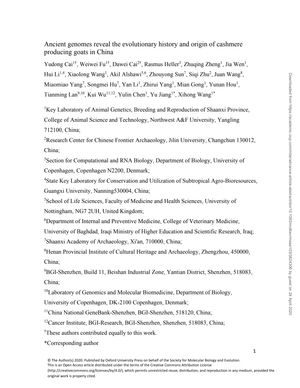Ancient Genomes Reveal the Evolutionary History and Origin of Cashmere-Producing Goats in China
April 2020
in “
Molecular Biology and Evolution
”
FGF5 EDA2R hair follicle development genes genetic divergence selective sweep regions candidate genes 504-bp deletion cashmere production seasonal expression pattern artificial selection genetic evolution adaptation to climate hair density hair follicle genes genetic selection gene deletion cashmere traits climate adaptation

TLDR Ancient Chinese goats evolved cashmere-producing traits due to selective breeding, particularly in genes affecting hair growth.
The study sequenced 27 ancient Chinese goat genomes from the Late Neolithic to the Iron Age, revealing genetic continuity with modern Chinese goats and indicating their origin from the eastern Fertile Crescent. The modern goats were divided into northern and southern groups, with significant genetic divergence in two hair follicle development genes, FGF5 and EDA2R. A deletion near FGF5, which may affect hair density, became more frequent over time in northern goats, while EDA2R showed older variation. The research identified 24 selective sweep regions with 33 candidate genes, with the strongest selection signals in FGF5 and EDA2R. The FGF5 gene had a 504-bp deletion associated with increased cashmere production in northern Chinese goats. EDA2R showed a seasonal expression pattern and increased frequency in northern goats during the Iron Age. The study suggests that the genetic differences in hair follicle-related genes between northern and southern Chinese goats were likely due to artificial selection, possibly influenced by the cooler temperatures of the Little Ice Age. This study provides insight into the genetic evolution of Chinese goats, particularly regarding their adaptation to climate and the development of cashmere-producing traits.






